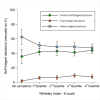Association between health anxiety and self-triage decisions: evidence from a cross-sectional study with Australian emergency department non-urgent patients
- PMID: 40246563
- PMCID: PMC12007045
- DOI: 10.1136/bmjopen-2024-090123
Association between health anxiety and self-triage decisions: evidence from a cross-sectional study with Australian emergency department non-urgent patients
Abstract
Objective: The aim of this exploratory study was to investigate the association between health anxiety and self-triage decisions among emergency department non-urgent patients.
Design: Cross-sectional single-centre study SETTING: Emergency department in the Princess Alexandra Hospital in Brisbane, Australia PARTICIPANTS: Between 13 December 2022 and 30 August 2023, an exhaustive recruitment strategy was deployed to recruit 400 patients. Eligible participants were patients aged 18 years or above who belonged to the Australasian Triage Scale category four or five (non-urgent), were physically and mentally capable of participating in the study and presented to the emergency department between 6:00 a.m. and 23:00 p.m. during the study period.
Main outcome measures: The primary outcome was accurately self-triaged decisions, while the secondary outcome was inaccurately self-triaged decisions, including both overtriaged and undertriaged decisions. Self-triage decisions were assessed using six hypothetical medical scenarios.
Results: Regression results revealed that health anxiety was not associated with accurately self-triaged decisions. However, compared with non-urgent patients exhibiting no health anxiety, those in the third and fourth quartiles (the upper two quartiles) of the Whiteley Index-6 were expected to make 0·29 (95% CI 0·09 to 0·50) and 0·25 (95% CI 0·07 to 0·44) more overtriaged decisions (mean=0·42; SD=0·71), respectively. In contrast, negative associations between health anxiety and undertriaged decisions were observed. Subgroup analyses by age showed statistically significant associations between health anxiety and inaccurately self-triaged decisions among the older adult patient group (aged 35-79 years). Moreover, analyses stratified by sex revealed that female and male patients in the fourth quartile of the Whiteley Index-6 were expected to make 0·26 (95% CI 0·02 to 0·49) and 0·27 (95% CI 0·05 to 0·48) more overtriaged decisions, respectively, compared with those with no health anxiety.
Conclusions: Our results suggest no significant association between health anxiety and accurately self-triaged decisions. In contrast, health anxiety was associated with inaccurately self-triaged decisions. This implies that patients with health anxiety overestimate the need for healthcare and therefore could substantially impact the misuse of health services, particularly emergency departments.
Keywords: Economics; Health Services; Health policy.
© Author(s) (or their employer(s)) 2025. Re-use permitted under CC BY-NC. No commercial re-use. See rights and permissions. Published by BMJ Group.
Conflict of interest statement
Competing interests: Thilini Nisansala Egoda Kapuralalage had financial support from the PA Research Foundation for the submitted work. All other authors (HFC, JH, BT, SW) have no competing interest to declare.
Figures
Similar articles
-
Assessing sensitivity and specificity of the Manchester Triage System in the evaluation of acute coronary syndrome in adult patients in emergency care: a systematic review protocol.JBI Database System Rev Implement Rep. 2015 Nov;13(11):64-73. doi: 10.11124/jbisrir-2015-2213. JBI Database System Rev Implement Rep. 2015. PMID: 26657465
-
Undertriage of Trauma-Related Deaths in U.S. Emergency Departments.West J Emerg Med. 2016 May;17(3):315-23. doi: 10.5811/westjem.2016.2.29327. Epub 2016 May 2. West J Emerg Med. 2016. PMID: 27330664 Free PMC article.
-
Clinical decision-making: Cognitive biases and heuristics in triage decisions in the emergency department.Am J Emerg Med. 2025 Jun;92:60-67. doi: 10.1016/j.ajem.2025.02.043. Epub 2025 Feb 27. Am J Emerg Med. 2025. PMID: 40073709
-
Triage Performance in Emergency Medicine: A Systematic Review.Ann Emerg Med. 2019 Jul;74(1):140-152. doi: 10.1016/j.annemergmed.2018.09.022. Epub 2018 Nov 22. Ann Emerg Med. 2019. PMID: 30470513
-
Triage implementation audit at the adult emergency department of Debre Tabor Comprehensive Specialized Hospital in Ethiopia.Afr J Emerg Med. 2024 Dec;14(4):506-511. doi: 10.1016/j.afjem.2024.10.001. Epub 2024 Dec 7. Afr J Emerg Med. 2024. PMID: 39720011 Free PMC article. Review.
References
-
- Redelmeier DA, Rozin P, Kahneman D. Understanding patients’ decisions. Cognitive and emotional perspectives. JAMA. 1993;270:72–6. - PubMed
-
- Hall EC, Cooper AA, Watter S, et al. The Role of Differential Diagnoses in Self‐Triage Decision‐Making. Applied Psych Health & Well . 2010;2:35–51. doi: 10.1111/j.1758-0854.2009.01021.x. - DOI
-
- Australian Institute of Health and Welfare . Canberra (AU): AIHW: Health services series no. 89. Cat. no.HSE 216; 2018. Emergency department care 2017–18: australian hospital statistics.
MeSH terms
LinkOut - more resources
Full Text Sources
Medical


